
Bradley Brenden Madhoo
African Forests: Revitalizing Nature’s Heart Through Indigenous and Innovative Conservation
Most Read Stories Today
-
Water Scarcity and Artificial Rainfall: The Positive and The Negative Effects of Cloud Seeding, including Health Hazards and Climate Implications.
-
Renewable Energy in Rural Areas: Challenges, Opportunities, and Successful Rural Projects
-
Pakistan's Agriculture at Risk Due to Climate Variability
-
South Africa's Recent Floods: Is Climate Change to Blame?
-
South Korea's floods: root causes and prevention strategies.
-
South Africa: Cape Town, A City Under Fire
-
The Human Cost of Climate Disasters
-
Our Oceans, Our Future: The South African Dilemma of Overfishing
-
Degenerative Impact of Hydrocarbons On The Environment.
-
Sustainable Urban Planning - Copenhagen and the Path to Climate Resilience
When we think of Africa’s forests, we might picture breathtaking landscapes teeming with life. But they’re more than just beautiful scenery. These forests, covering about 15% of the world’s forested land, act like the planet's lungs—absorbing carbon and releasing oxygen.
The Congo Basin, often dubbed the “second Amazon,” alone stores 8% of the world’s carbon. This incredible area is a key player in the fight against climate change, helping to absorb carbon emissions that otherwise contribute to global warming.
However, these vital ecosystems are under siege. Each year, around 10 million acres of forest are lost due to logging, agriculture, and urban expansion. On top of that, climate change is adding extra stress, disrupting ecosystems and threatening the traditional ways of life for Indigenous communities who have lived in harmony with nature for generations. Yet, amidst these struggles, there’s hope.
Indigenous communities and conservation organizations are banding together, harnessing both traditional knowledge and modern techniques to protect and rejuvenate these essential forests.
The Wisdom of Indigenous Communities
Indigenous groups across Africa, like the Pygmies in the Congo Basin, have been caretakers of their lands for centuries, fostering biodiversity with their traditional practices. These communities possess a deep understanding of local ecosystems and play a crucial role in conservation efforts.
For example, during the turbulent times of the 1996 war in the Democratic Republic of the Congo, Pygmies stepped in to protect mountain gorillas from poachers, showcasing their commitment to safeguarding these magnificent animals.
Pygmy women are particularly vital in sustainable forest management by skillfully using natural resources to benefit their communities, while they ensure biodiversity thrives. However, barriers such as limited access to resources and training can hinder their involvement.
By supporting initiatives that empower Indigenous women with training, land rights, and tools, we can enhance conservation efforts and promote sustainable development in Africa’s forests.
Success Stories in African Reforestation
Across Africa, inspiring reforestation projects are proving that blending Indigenous wisdom with innovative practices can restore ecosystems and boost resilience against climate change.
-
Singita Kwitonda Lodge Orchid Project, Rwanda
In Rwanda, this project aims to restore habitats for endangered species by reintroducing over 5,000 native orchids. By focusing on specific plants that support local wildlife, the project shows how targeted conservation can bring ecosystems back to life. -
Gishwati National Park Restoration, Rwanda
Once rich in biodiversity, Gishwati Forest lost 98% of its area to deforestation. Now, the Forest of Hope Association, led by agronomist Beatrice Nyiransabimana, is working to restore this vital ecosystem by nurturing native tree nurseries, providing homes for rare species like golden monkeys and chimpanzees. -
Seedball Project, Kenya
This innovative project demonstrates how simple ideas can drive significant change. “Seedballs,” made by coating seeds in charcoal dust, can be scattered easily across degraded lands. They’re especially effective in Kenya’s dry regions, helping to rejuvenate over 13 million acres. -
Segera’s Tree of Life Initiative, Kenya
In Kenya’s Laikipia region, this project aims to plant one million trees to restore degraded land. This effort boosts soil health and water availability, and also enhances food security for local communities. -
Zanzibar Coral Reef Reforestation, Tanzania
Conservation efforts are not limited to forests on land. Evidently so, in Zanzibar, the Coral Reef Care organization is working to rebuild damaged coral reefs, which are essential for marine life and act as a buffer against storms, supporting local fishing communities. -
Babuluko Forest Concession, Democratic Republic of the Congo
In a groundbreaking move, the Congolese government has granted land rights to the Babuluko Pygmy communities over a 15,000-hectare forest. This recognition allows them to use their traditional knowledge to protect biodiversity, combat poaching, and prevent illegal logging.
Facing Conservation Challenges Head-On
Despite these positive developments, conserving Africa’s forests is not without its hurdles. Illegal logging, mining, and unsustainable farming practices continue to threaten these areas. Armed conflicts and weak legal frameworks can leave Indigenous communities vulnerable, undermining their efforts.
To tackle these issues, it’s essential to empower local communities through education, regulations on hunting, and initiatives that promote sustainable livelihoods. Further, supporting income-generating activities that respect the ecosystem, communities can reduce their reliance on harmful practices. The resilience and expertise of Indigenous groups, combined with broader support, are crucial for overcoming these challenges.
Building a Brighter Future for African Forests
The conservation efforts underway in Africa showcase what’s possible when Indigenous peoples, conservationists, and governments unite. By engaging with these initiatives—whether through eco-tourism, donations, or advocacy—we all have a part to play in restoring Africa’s forests.
These efforts help safeguard our planet’s biodiversity, and also empower communities to establish sustainable conservation models for the future.
Therefore, celebrating and preserving Africa’s forests means protecting a vital resource for climate stability, biodiversity, and the cultural heritage of Indigenous peoples. The synergy of tradition and innovation offers a hopeful path forward, demonstrating that even in the face of immense challenges, Africa’s forests can flourish once more.
References
-
7 Reforestation projects that are regreening Africa. (n.d.). Alluring Africa. https://www.alluringafrica.com/7-reforestation-projects-that-are-regreening-africa/
-
Braverman, M. (2018, September 28). Forest cover 56 – community conservation in Africa. Global Forest Coalition. https://globalforestcoalition.org/forest-cover-56/
-
Deugoue, S. D. (2019, April 30). Indigenous culture key to protecting forests. Green Peace. https://www.greenpeace.org/africa/en/blogs/6960/indigenous-culture-key-to-protecting-forests/

Terms & Conditions
Subscribe
Report
My comments